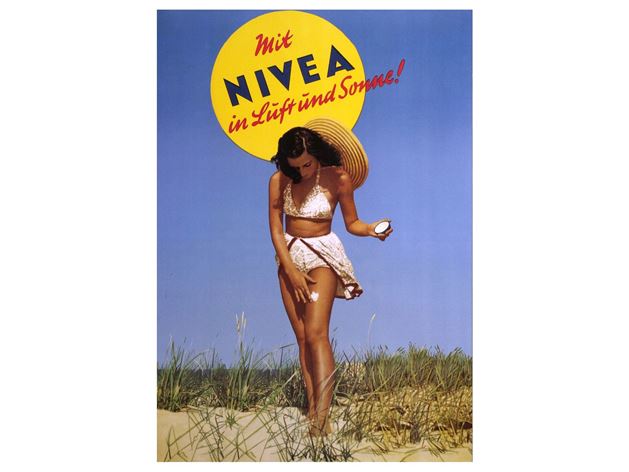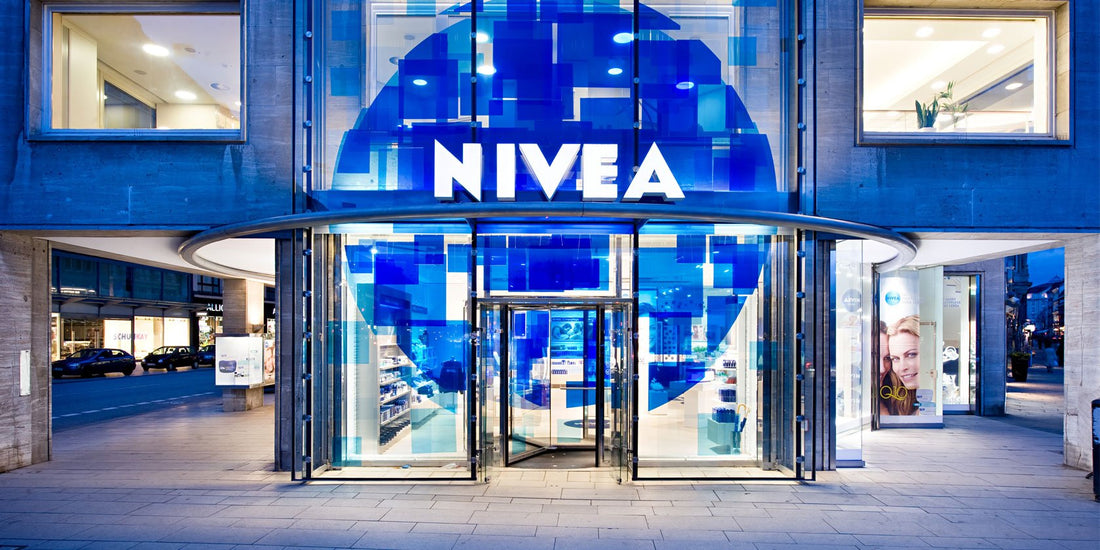______________________________________________________________________________________________
The Early Days
[caption id="attachment_2592" align="aligncenter" width="629"] An ad for NIVEA from 1912[/caption]
In 1911, Isaac Lifschutz developed a compound known as Eucerit—an emulsifier that combined oil and water into a stable mixture. In that same year, a professor named Paul Gerson Unna presented this compound to Dr. Oscar Troplowitz, a chemist.
Troplowitz had a hunch that Eucerit would be the perfect ingredient for a cosmetic cream. Together with Unna, he worked to create “the mother of all cream” – something that would harness the moisturizing power of the new discovery. They decided upon the name NIVEA, from the Latin “Nix, Nivis” which translates to “snow white.”
The cream took off – by 1914, Troplowitz had founded the company Beiersoft and developed a talc, soap, and hair milk to go along with the “miracle cream.” The products were shipped all around the world – 42 percent of all NIVEA sales were abroad. Thanks to the stable composition of the cream, it was easily able to withstand the lengthy shipments.
In 1924, NIVEA rolled out its now-iconic blue tin. In the same year, the brand expanded into Men’s grooming when it introduced a shaving soap. It also began advertising campaigns that introduced the Nivea Boys and Nivea Girls, who would become local celebrities, greeted everywhere they went with a “Hello NIVEA!”
An ad for NIVEA from 1912[/caption]
In 1911, Isaac Lifschutz developed a compound known as Eucerit—an emulsifier that combined oil and water into a stable mixture. In that same year, a professor named Paul Gerson Unna presented this compound to Dr. Oscar Troplowitz, a chemist.
Troplowitz had a hunch that Eucerit would be the perfect ingredient for a cosmetic cream. Together with Unna, he worked to create “the mother of all cream” – something that would harness the moisturizing power of the new discovery. They decided upon the name NIVEA, from the Latin “Nix, Nivis” which translates to “snow white.”
The cream took off – by 1914, Troplowitz had founded the company Beiersoft and developed a talc, soap, and hair milk to go along with the “miracle cream.” The products were shipped all around the world – 42 percent of all NIVEA sales were abroad. Thanks to the stable composition of the cream, it was easily able to withstand the lengthy shipments.
In 1924, NIVEA rolled out its now-iconic blue tin. In the same year, the brand expanded into Men’s grooming when it introduced a shaving soap. It also began advertising campaigns that introduced the Nivea Boys and Nivea Girls, who would become local celebrities, greeted everywhere they went with a “Hello NIVEA!”
Mid-Century Innovation
[caption id="attachment_2596" align="aligncenter" width="629"] An ad from the 1950s[/caption]
The middle of the century saw many Europeans focus more on family. Post-World War II, the world experienced an unprecedented baby boom. Birth rates boosted by upwards of 20% in some years. NIVEA kept up with this boom by developing a whole line specifically for sensitive baby skin.
In the 1950s and 1960s, traveling and vacationing became very popular with Europeans. The majority of the destinations targeted for these voyages were bright and sunny. The NIVEA scientists followed this trend by helping to determine the concept of sun protection factor, or SPF. By 1975, NIVEA had begun indicating SPF on the packaging of their sun protection products.
In the 1980s, NIVEA rolled out a whole line dedicated to Men’s grooming, starting with an alcohol-free aftershave in 1980. When NIVEA Men was solidified in 1986, the line included everything from shampoos to styling products with even some anti-aging products.
An ad from the 1950s[/caption]
The middle of the century saw many Europeans focus more on family. Post-World War II, the world experienced an unprecedented baby boom. Birth rates boosted by upwards of 20% in some years. NIVEA kept up with this boom by developing a whole line specifically for sensitive baby skin.
In the 1950s and 1960s, traveling and vacationing became very popular with Europeans. The majority of the destinations targeted for these voyages were bright and sunny. The NIVEA scientists followed this trend by helping to determine the concept of sun protection factor, or SPF. By 1975, NIVEA had begun indicating SPF on the packaging of their sun protection products.
In the 1980s, NIVEA rolled out a whole line dedicated to Men’s grooming, starting with an alcohol-free aftershave in 1980. When NIVEA Men was solidified in 1986, the line included everything from shampoos to styling products with even some anti-aging products.
Into the Future
[caption id="attachment_2591" align="aligncenter" width="629"] And ad from 2015[/caption]
As technology became more advanced in the late 1990s, NIVEA was able to better analyze the needs of mature skin. In 1998, a product line was introduced that had been created using image-mapping tech. This line incorporated a special ingredient known as Coenzyme Q10, a powerful antioxidant that mimics vitamins naturally found in the skin.
Most recently, NIVEA introduced a line of in-shower lotions that really shook up the moisturization scene. These products work a little like hair conditioners, in that you apply them in the shower and let them sit for a while before rinsing off.
[caption id="attachment_2606" align="aligncenter" width="1074"]
And ad from 2015[/caption]
As technology became more advanced in the late 1990s, NIVEA was able to better analyze the needs of mature skin. In 1998, a product line was introduced that had been created using image-mapping tech. This line incorporated a special ingredient known as Coenzyme Q10, a powerful antioxidant that mimics vitamins naturally found in the skin.
Most recently, NIVEA introduced a line of in-shower lotions that really shook up the moisturization scene. These products work a little like hair conditioners, in that you apply them in the shower and let them sit for a while before rinsing off.
[caption id="attachment_2606" align="aligncenter" width="1074"] The NIVEA cream tin design throughout time[/caption]
The NIVEA cream tin design throughout time[/caption]
Is German NIVEA Really Different?
One of the reasons that the NIVEA that we sell on the Smallflower site is so popular is because many people think that German NIVEA is different than the NIVEA commonly sold in the US. American NIVEA is produced in a plant in Mexico and has a slightly different formulation than its European counterpart. This thread on Reddit's Skincare Addiction community delves deep into the formulation differences, exposing what exactly changes between the two varieties. Smallflower customers have opinions about the differences as well. Reviewer Chase C. says, "I'm an avid NIVEA fan (of any version sold worldwide). However, I prefer the German NIVEA hands down! The NIVEA that is made in Germany does not have some of the preservatives that NIVEA made elsewhere has and it moisturizes my skin without the greasy after feeling that some of the other versions tend to impart. It smells the same worldwide (in my opinion), but the feeling on the skin is what differs."_____________________________________________________________________________________________
We hope you've enjoyed learning a little bit more about one of our favorite German brands. Is there a NIVEA product that you love? You can find it in our collection here →
